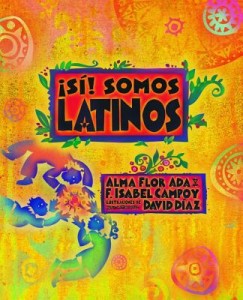By Alma Flor Ada and F. Isabel Campoy, pictures by David Diaz
Voices! The power and pride singing throughout this book is felt in each of the thirteen distinctive narrative poems. Each poem is told in the first-person voice of a Latino child who introduces his or her unique cultural background and situation. Personalities shine. Individuals become real. Stories touch your heart. Each poem is followed by a few pages of informative nonfiction that outlines related aspects of the child’s history and culture. What a rich and diverse bouquet of celebration!
READERS of all ages, this is a stunning book that crumbles stereotypes. For a chance to receive a complimentary copy, leave a comment and we will draw names from our “book hat.”
May I introduce Juanita who says:
“I am Mexican, I live in New York. I am Latina.”
But unknown to her teacher, her home language is not Spanish, but Mixtec, a “secret language that no one in this school even suspects exists.”
And then a surprise arrives at Juanita’s classroom – a new student, Elena….
“Next to the teacher stands a girl –
her skin the same rich color as mine,
her hair, black, long, and as straight as mine, and
her face showing the same surprise as mine —
a surprise that makes her dark eyes sparkle
like black obsidian in the sun….”
Meet for a moment, Rocio, whose grandparents were refugees from Spain during the terrible times when General Franco was the dictator. Rocio shares lines from her grandparent’s diary and then her impressions when —
“A year ago I went with Abu Amaya to see Guernica –
the town…that inspired Picasso
to paint the horror of the war….”
These individual voices will touch your heart. David Diaz’s bold woodcut illustrations done in the style of the “papel picado” add a rich visual, especially his shadow silhouettes.”
I asked the authors, Alma Flor Ada and F. Isabel Campoy about their creation of this remarkable book. Here are their responses:
Isabel’s perspective
During our visits to schools we have had the fortune to meet countless numbers of Latino teachers, parents, and children. Those encounters have always provided a rich communication between us about the many things we all shared as Latinos, and the ones we did not, all within the same culture.
We met parents from different countries, grandparents that added sometimes two or more backgrounds to the mix of the same family. We met Latino children that only spoke English, children that only spoke Spanish, bilingual children that proudly walked the bridge of their Latino culture.
I was born in Spain, but I consider myself Latina. I have lived longer in the United States that in my native country. The story told in the book about Alicante, is a true story. The realities of war and the poverty that follows, is an unfortunate reality Spain and Latino America have shared.
I often repeat that I am a mestiza, of cultures, of ways to see life, and I think is a virtue to belong to an identity that can feel, love, laugh and cry in more than one color.
In Yes! We Are Latinos and now also in its Spanish version ¡Sí! Somos latinos we have tried to explain to us and to anyone curious about our identities, who we are, where do we come from, what the realities we have survived and which we are still suffering are, and how, only through knowledge, we will be free.
History belongs to those who write it. We have already taken the pen in hand!
Alma’s perspective
As Isabel has mentioned, knowledge is necessary to enjoy true freedom. As a life-long educator I have felt the need to share with young people, Latinos and non-Latinos alike, important moments of our history. But I do not believe that information can only be presented through non-fictional text, but, instead I strongly believe that literary narrative can provide the deepest aspects of reality, what Unamuno called the “intra-historia”, the daily experiences, that support the official history.
The free-verse vignettes that introduce each of the chapters of the book are meant to make the facts alive through realistic characters, boys and girls who live the consequences of the facts presented.
It is our hope that their portraits –based on composite of real life individuals we have known throughout our lives- will not only be good motivators to read about the history of their people, but that they will be memorable, and, become a motivation for the readers to want to get to know better their own relatives, friends, and classmates, and perhaps offer some insights about themselves.
David Díaz’s contribution has enriched the book. By making his woodcuts in the style of “papel picado,” a beloved handcraft, he offers an additional element of authenticity to the narrative.
We were absolutely delighted seeing how he could capture the essence of the characters and embellish the book with those black silhouettes.
Published by Charlesbridge, 2013.











Any book, article or blog coming from the creative genius of Alma Flor Ada must be extraordinary. As a passionate reader and writer, I have always appreciated her books and the artistic collaboration with Isabel Campoy and David Díaz. I will order both the English and Spanish versions today.
Thank you for your enthusiastic comments. Yes, Alma Flor Ada’s books are amazing … important … and open windows of compassion.